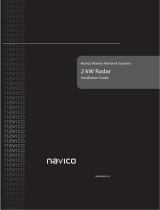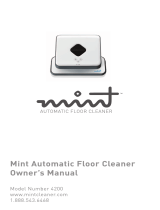Page is loading ...

The instructions in this guide provide a basic overview for quickly getting results from a NorthStarlighting
solution. They are intended to get you up and running quickly, and should be used for initial testing and proof of
concept operations.
Installation Overview:
l Connect the site controller and turn it on
l Log in to the site controller
l Configure the controller's location and time settings
l Change the site controller's default password
l Conduct a system census to discover lights
l Configure and place lights
l Control the lights
Once these steps are complete, you'll have a good feel for how a full installation will work and behave, and a
clearer picture for how you'll want the full installation to be configured.
System Requirements
l Leviton NorthStar Site Controller
l Leviton light controllers
l Laptop or tablet running the Google Chrome browser
Leviton Manufacturing Co., Inc. Lighting & Energy Solutions
20497 SW Teton Avenue // Tualatin, OR 97062
(503) 404-5500 // www.leviton.com/
©2016 Leviton Manufacturing Co., Inc. All rights reserved. Subject to change without notice
NorthStar
Q uic k I nst all Guide
116-071620-019-A000

Lighting System Configuration Overview
A NorthStar lighting solution consists of a NorthStar Site Controller and some number of lights equipped with
Leviton light controllers, and potentially sensors and/or switches.
The NorthStar Site Controller serves as the hub of control and communications for managing the lights that
make up the lighting solution.
Setting up the NorthStar Site Controller
The first step in installing a NorthStarlighting solution is to connect the physical hardware of the system, followed
by configuration of the system within the NorthStaruser interface. These instructions assume that you have
already physically installed the hardware that will make up your NorthStarlighting solution and you are now
ready to connect the site controller.
Page 2| NorthStar Quick Install Guide

To install the NorthStarsite controller:
1. Unpack the NorthStar Site Controller.
2. Attach the included antennas to the site controller as
shown. When looking at the top of the site controller
(with the mounting bracket on the back side), the
longest antenna (SNAP antenna) attaches to the
left-most antenna connector, and the shorter Wi-Fi
antenna attaches to the middle connector. If the site
controller that you're installing has cellular capability,
the optional cell antenna is attached to the
remaining connector.
Leviton-provided antennas will have white dots at
the base of the antenna that denote the type. One
dot is a SNAPantenna, two is for a Wi-Fi antenna,
and three is for a cellular antenna. This notation is
also reflected on the front unit label of the site
controller.
3. Plug the provided power supply into the barrel
connector and then into an 110VAC outlet. When the
NorthStar Site Controller powers up, orange LEDs
will light up for approximately 30 seconds while the
site controller software starts up. Once this is
complete, the orange LEDs will turn off and the site controller will be ready to use.
Software Configuration and Logging In
The NorthStar Site Controller comes preconfigured with the NorthStar software so there is no user installation
of software required.
The current version of the NorthStar software only supports the Google Chrome browser. Other browsers will be
supported in future releases. If you don’t have the Google Chrome browser installed on your device, please
download and install it from this location:
http://www.google.com/chrome
Accessing the Site Controller
The NorthStar Site Controller supports LAN(Ethernet)and WI-FIconnections. The NorthStar Site Controller
acts as an access point and broadcasts its Wi-Fi SSID over the air. During installation the Wi-Fi connection is used
to establish communications between the controller and a browser based device such as a computer or tablet.
After that, it can be accessed via Ethernet or Wi-Fi.
3

The SSID that is broadcast from the site controller should be visible from the network connections panel of your
computer or tablet. It will appear in your network connections list as SimplySNAP_XXXXXX where XXXXXX is
the specific address of the site controller. This address is unique to each site controller and is the last 6
alphanumeric characters of the Ethernet MAC address.
The Wi-Fi connection to the
site controller is secure. Once
you select the SSID and your
computer attempts to
connect to the site controller,
it will prompt you for a
password to complete the connection.
Enter the password synapse!wireless to establish the connection.
When this password is entered a connection is established and will appear
in your network settings similar to what is shown below. This may appear
as an “Unidentified network” with no Internet access.
Next, launch the Chrome browser and enter HTTPS://192.168.55.1 in the
address bar.
Make sure it is entered exactly as shown. (This is a secure connection to a
specific IP address that is the factory default within the site controller). This connection mimics a connection to an
internet access point.
You will receive a warning as shown at right. Click the
Advanced link at the bottom, then click the "Proceed to
192.168.55.1 (unsafe)" link. (This warning is displayed because
the site controller is using an unsigned security certificate.)
The NorthStar dashboard should now appear in your browser
and present you with the login screen for the NorthStar site
controller.
Enter the following username and password:
Username: snap
Password: qwerty
After you log in, navigate to the NorthStar dashboard page by clicking the Dashboard menu selection.
Page 4| NorthStar Quick Install Guide

The Dashboard
The dashboard provides an overview of the components that make up your NorthStarsystem.
NOTE: For more information on the Dashboard and menu choices, please see the NorthStarUser Guide.
Discovering Unconfigured Devices
You'll next want to add a few devices to the system to get a feel for how it works. Again, these instructions are for
getting a quick idea of how easy the system is to configure and use, and not intended to be used for a full
installation. Please consult the NorthStarUser Guide for full instructions.
NOTE: Before proceeding, make sure all of your lighting controllers are properly installed and power is
applied.
You can click the Unconfigured Devices icon on
the Devices &Zones page to perform a "census"
of the unconfigured NorthStar devices on your
channel and network ID. These devices will
appear in a list to provide you with an easy way to
configure them.
If you are adding several devices in this manner,
we recommend that you perform the census two
or three times to ensure that all devices were
discovered.
5

To perform a census of unconfigured devices:
1. Click the Devices & Zones menu choice in
the left menu panel, then click the Census
Icon.
2. Click the Start Census button at the top of
the screen. NorthStar will begin to search
for unconfigured devices in your network.
3. If unconfigured devices are discovered, you
will be presented with a list of the devices.
To add a device to your network, click the
Add Device button to the left of the device
you wish to add. The new device will appear in a pane on the Devices &Zones page.
NOTE: If the lighting controller does not automatically identify its type as part of the census, you can
manually select the proper type using the drop-down menu.
4. Once the device is loaded, you can edit it as you would any other device. For more information on editing
devices, please consult the NorthStaruser guide.
Activating, Deactivating and Dimming Lights
After a light is entered into the system it can be controlled directly from the Devices and Zones page. Broader
control can be accomplished through the use of zones, schedules, and sensors, which are explained fully in the
NorthStarUser Guide.
The light may be switched on and off using the toggle switch in the lower left of the light panel, while dimming can
be controlled using the slider switch in the center of the panel.
Page 6| NorthStar Quick Install Guide

Next Steps
You have now completed the NorthStar lighting solution introduction. For more detailed information, including
administration and configuration of zones, sensors, and behaviors, consult the NorthStar user manual.
7
/



